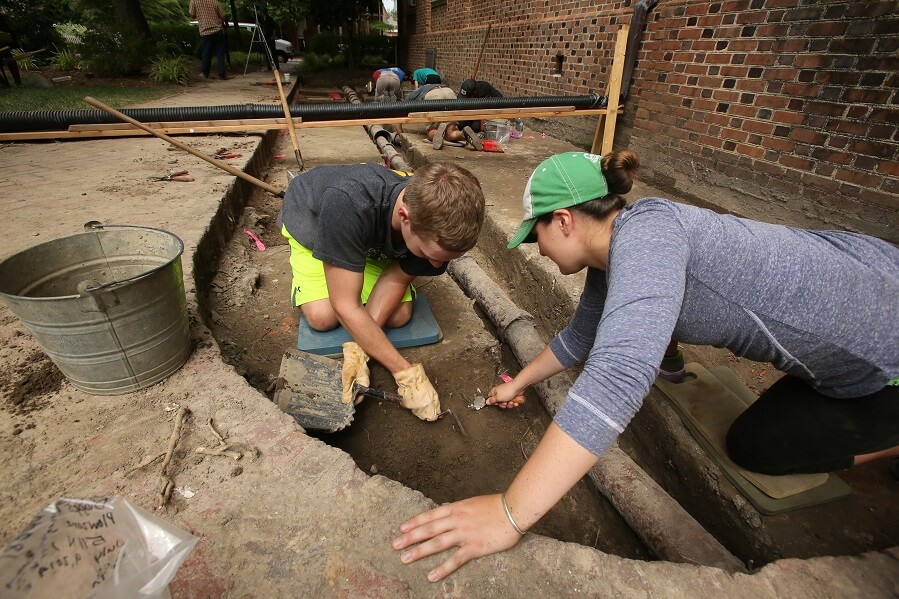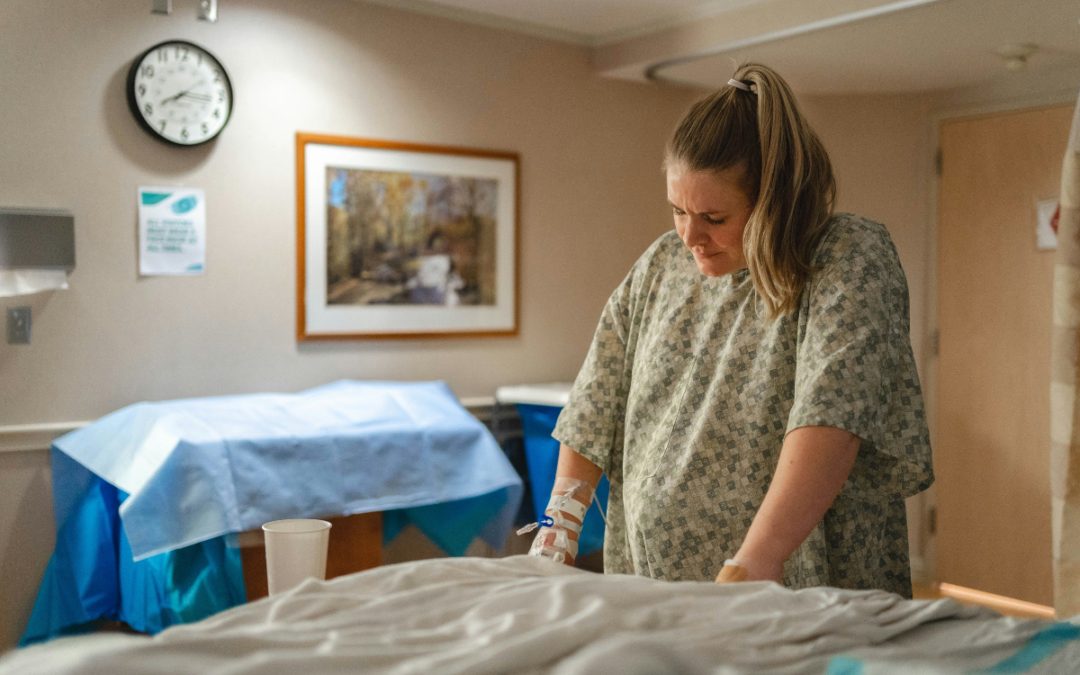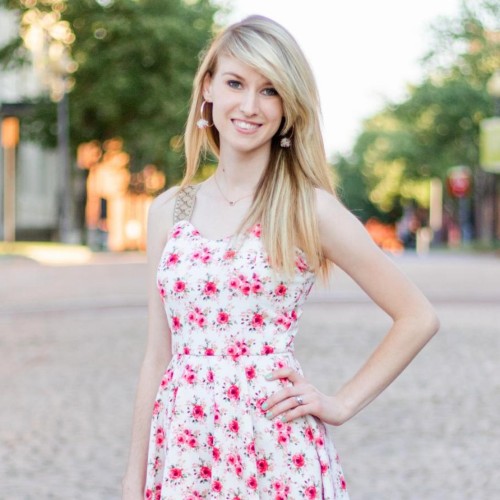
Archaeologists have a month to find the smoking lunchbox of the Bray School, and Terry Meyers has lost none of his optimism. For the past three summers, archaeologists have dug up the grounds of a William & Mary dorm in search of the “smoking lunchbox”—the archaeologists’ term for a material-culture connection between the 18th-century Bray School and a building still in use on the William & Mary campus. Meyers, Chancellor Professor of English at William & Mary, traced the location of the Bray School to a lot at the corner of North Boundary and Prince George streets. He further has proposed that the building that hosted the school still stands on the William & Mary campus; it’s now known as Prince George House and houses William & Mary’s ROTC program.
Dedication and determination revealed the 18th century Williamsburg Bray School, hiding in plain sight for nearly 250 years.
WILLIAMSBURG – If you’re walking along Prince George St. in Williamsburg, chances are you won’t see Bray School. Well, it’s not that you won’t see it. You probably will. But recognizing it as such presents difficulties.
Even those who looked for the oldest existing Bray schoolhouse in the United States – and knew its approximate location – had difficulty finding it.
In February, that changed.
The Search Begins
About 17 years ago, Terry Meyers, Chancellor Professor of English, Emeritus, at William & Mary, found himself walking up and down Prince George St. He was on a mission – a treasure hunt, of sorts.
Meyers looked for signs of a once-standing Williamsburg Bray School, which taught enslaved and free African-Americans during the colonial period. The school moved locations in the 1930s, making way for an on-campus dormitory. After that, the Bray School all but disappeared from existence.
About 70 years later, Meyers took an interest in the school after reading about it in a memoir written by an individual who grew up in Williamsburg in the 1930s. From that, he learned about the school and set out to find it.
Meyers traversed the street the Bray School moved to time and time again. He recalled seeing structures. However, not a single one dated nearly as early as the 1760 schoolhouse he sought.
“I walked over to that part of our campus and walked along Prince George St. looking for an 18th century cottage. And I simply couldn’t see one,” Meyers said. “And so I thought, ‘Well, you know, it was moved in 1930.’ This was about 2003 or 2004. ‘That’s a long time. It’s probably been demolished and is long since gone.’”
Looking for Bray School
Just shy of giving up, Meyers went to the library, determined to at least close the chapter on his search through additional research. Once again, he found little to suggest a 200-some-year-old school survived unknown until the new millennium.
What he found instead were a few newspaper clippings from the 1930s and 40s. They showed a house in the school’s approximate location, one that Meyers passed multiple times.
But everyone in Williamsburg knew that as the Dudley Digges House, named after the uncle of a Yorktown patriot of the same name. Still, Meyers took a second glance at the photographs.
“When I looked at those clippings, they showed pictures of a house that had been altered from an 18th century cottage,” Meyers said.
The professor went back to Prince George St., equipped with a hunch. He stopped at house number 524 and used his imagination.
“The cottage as it is today has sort of additional add-ons to both the left and the right sides of the building,” Meyers said. “It has a roof that is, I think it’s strictly speaking, called a gambrel roof.”
That means the roof has two sides, each of which has a shallower slope above a steeper one. It’s a style similar to that of many classic storybook dairy barns.
“I realized that as you look at that current building, if you can sort of erase the left and right additions, and if you sort of move the roof line back, tilt it back the way an 18th century cottage roof would have been, all of a sudden you have a building that looks like an 18th century structure,” Meyers said.
All along, the Bray School stood in plain sight. Or so it seemed. Next came authenticating Meyers’ hunch.

Dating the Structure
Gaining permission from William & Mary, Colonial Williamsburg performed a dendrochronology analysis in 2020. They removed the siding off of a small portion of the Digges House in search of a wood sample from the original structure.
What the group found confirmed Meyers’ intuition. They published their findings in February.
“We were able to find a number of samples that were felled, some in the fall and winter of 1759 and others in the spring of 1760,” said Ron Hurst, Colonial Williamsburg’s vice president of historic resources.
The group determined that colonist built the structure in 1760. That, along with research, proved that the Digges House held classes as the Bray School.
The structure is now the Bray-Digges House.
Digging up the Truth
After Meyers’ initial discovery, people approached him with stories.
“I got really interested in this and I got a lot of help from librarians and archivists and historians at Colonial Williamsburg and on campus,” Meyers said. “Everyone had a little piece of what was turning out to be a puzzle. I knew that there was a puzzle there. Everyone knew. People, individual people knew small things.”
Meyers’ continued research led him to a 1769 list of children who attended the school. The list also included the names of their owners.
The second part of the discovery came as a grim reminder of the antebellum period in American history.
“I noticed on that list that there were two children owned by the college, Adam and Fanny. And that sort of all of a sudden made slavery very concrete to me,” Meyers said. “Now, I realized I worked for an institution that had been complicit in slavery, and I should have known that. I mean, I knew it, I suppose, in the abstract and the sense that William & Mary is an old, Southern school. You know, inevitably it would have been caught up in slavery. But I never really thought about it.”
Saving the Children of Bray School
Still a century away from the Emancipation Proclamation, the school didn’t seek to save students from the binds of slavery. A major motivation in the curriculum of the period focused on saving their souls.
“This was a philanthropic association that was dedicated to the religious education and the salvation of the souls of what they regarded as the heathens – you know, the Blacks who had not been baptized, were not Christian,” Meyers said. “And they wanted to set up schools to educate them, teaching them the catechism, finally to get them baptized so that their souls would be saved.”
Teachers preached not only about salvation, but also about accepting one’s fate. The lessons presented enslavement as less of an inhumane act, and more of a divine ordinance.
“Of course the nature of what was being taught was really kind of a very pro-slavery ideology because, you know, what they were teaching, they were on the one hand saving their souls and bringing them into the Christian faith and Christian religion,” Meyers said. “But they were also in effect preaching to the enslaved what God’s plan was.”

Learning at the Bray School
Meyers spoke about the period in which people believed God’s plan centered around hierarchy. He revealed what a lesson in the Bray School might’ve sounded like.
“You know, [they might say] ‘Some of us were born to be princesses and kings, and some of us are born to be in the middle-class. You’re born to be enslaved,’” Meyers said. “‘And our job, if we follow the will of God, is to accept that status that we have been given – not to protest it, not to try to overthrow it, but simply try to be as happy as we can be in where we’ve been placed.’”
The indoctrination taught at the Bray School excused slavery as a malpractice.
“If anyone was unhappy with ‘God’s plan,’ with where they’d been placed in this hierarchical role, well, ‘You just have to remember that when you die, have you been good? You go to heaven and you’re happy there.’”
It’s unclear what other education the children received from the Bray School. Evidence suggests children on the site, given unearthed items like clay marbles, a doll and sewing paraphernalia.
Meyers suggested children could have learned to read and write, given slate pencils found on-site during archeological digs. Other historians stray away from the written component. If children learned to write, they could forge a manumission document – a letter freeing enslaved individuals.
Future of Bray School
Thanks in part to a $400,000 grant from the Gladys and Franklin Clark Foundation, the Bray-Digges House will soon undergo extensive renovations and remodeling.
First, a team with document and then dismantle the two additions that flank the original structure.
“Then we will have a fair amount of restoration to do to the original 1760 structure, which is fragile at this point,” Hurst said. “But a great deal of it is still there.”
Soon, the house will move yet another time in its 261-year history.
“We aspire to move it to the historic area of Colonial Williamsburg to do a full restoration of the building and then have it open to the public seven days a week,” Hurst said. “The population of Williamsburg at the time of the revolution was 52% African-American and so it’s a big part of our story. And this is going to be a wonderful opportunity to help tell a more fulsome and accurate variation of that story.”
Over the next 14 months, the team plans to work on the house as-is. Next year, the move will take place. After that, the restoration work will begin. By 2024, Hurst expects to have the Bray-Digges House open to the public in time for the 250th Anniversary of the year that the school closed for good.
Amie Knowles reports for Dogwood. You can reach her at [email protected]
JOIN THE CONVERSATION: Sign Up For Dogwood’s Newsletter
Politics

It’s official: Your boss has to give you time off to recover from childbirth or get an abortion
Originally published by The 19th In what could be a groundbreaking shift in American workplaces, most employees across the country will now have...

Trump says he’s pro-worker. His record says otherwise.
During his time on the campaign trail, Donald Trump has sought to refashion his record and image as being a pro-worker candidate—one that wants to...
Local News

Virginia verses: Celebrating 5 poetic icons for National Poetry Month
There’s no shortage of great writers when it comes to our commonwealth. From the haunting verses of Edgar Allan Poe, who found solace in Richmond's...

Join the fun: Recapping Family Literacy Night’s storybook adventures
When’s the last time you read a book aloud with a loved one? If it’s difficult to answer that question, then maybe it’s time to dust off that TBR...





